Luogo E Segni
Punta Della Dogana: 24 March – 15 December 2019

The exhibition takes its title from a painting by Carol Rama included in the exhibition. The show brings together over one hundred works, by thirty artists, that establish a particular relationship with their urban, social, political, historical, intellectual setting. Highlights include a signature beaded curtain installation by Felix Gonzalez-Torres, and an array of Roni Horn’s iconic frosted blue glass lozenges.
PITTURA/PANORAMA: Paintings by Helen Frankenthaler, 1952–1992
Museo di Palazzo Grimani, Venice: 7 May – 17 November 2019
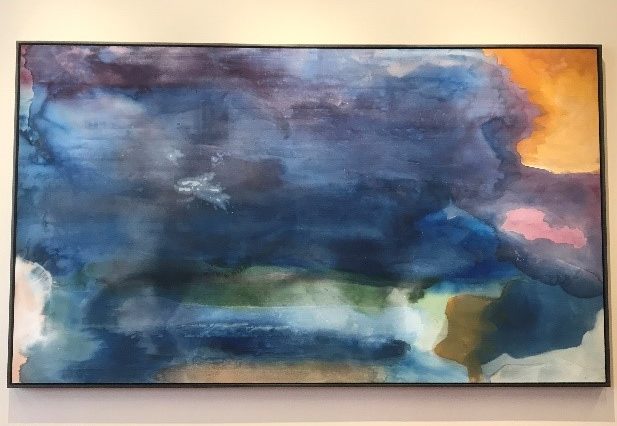
Abstract Expressonist Helen Frankenthaler’s famed colour-stained canvases have not been shown in Venice since 1966, when they held pride of place at the U.S. Pavilion of the Venice Biennale. The current exhibition at Palazzo Grimani, an art institution that dates back to the 16th century, is particularly fitting given the inspiration Frankenthaler gleaned from Venetian artists of that same era. The exhibition, curated by John Elderfield, includes work from four stages of the artist’s career, organized to illustrate the evolution of her career. The show focusses on the relationship in the artist’s development of the pittura (painting) and the panorama: the interplay of works like easel painting, although made on the floor, and large, horizontal paintings that open onto shallow but expansive spaces.
Sean Scully: HUMAN
Church of San Giorgio Maggiore: 8 May – 13 October 2019
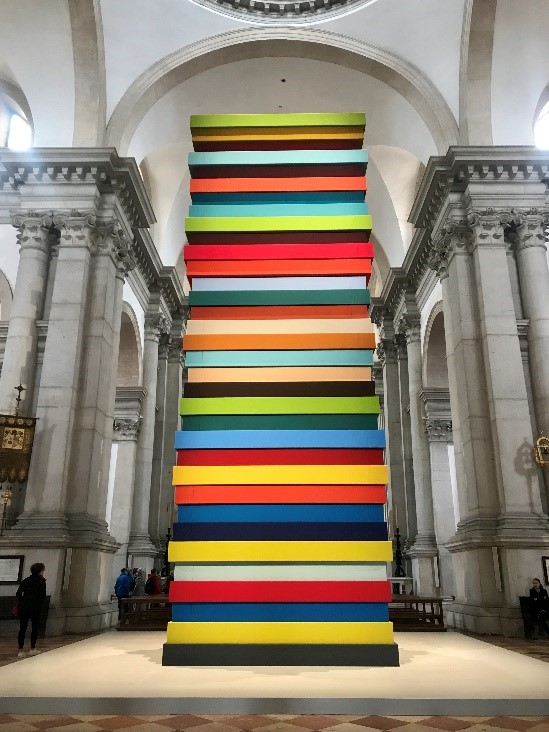
HUMAN is a solo exhibition of recent and new works by Sean Scully, presented in collaboration with the Abbazia di San Giorgio Maggiore. Curated by Javier Molins, the exhibition invites viewers to contemplate the link between the contemporary artist and the historic church. Scully presents his largest sculpture to date beneath the church’s central dome. Constructed from stacked frames, each wrapped in vibrant and varying colours of felt, the sculpture rises ten metres into the air like an elaborate Jacob’s ladder, leading the eye and spirit heavenwards through the Basilica’s dome. In the remaining spaces, the artist’s acclaimed Landline series are displayed alongside three new figurative portraits from a series entitled Madonna.
Baselitz – Academy
Gallerie dell’Accademia di Venezia: 8 May – 8 September 2019

Baselitz is the first living artist to have an exhibition at the Galleria dell’Accademia. The German artist is showing his feverish paintings and drawings, as well as deftly hewn figurative sculptures, ranging from across his more than 60-year career and including new work created specifically for the show. Baselitz’s oeuvre has always been about destabilising the image, most notoriously by turning it upside down. The Accademia exhibition aims to deepen our understanding of a familiar artist, Baselitz emerges nuanced, playful, wide-ranging. The show celebrates the infinite possibilities by which tradition, including that of Raphael & Giorgione, becomes inspiration for the acclaimed artist.
Edmund De Waal: Psalm
Canton Scuola Synagogue / Ateneo Veneto: 7 May – 29 September 2019

dmund De Waal’s Biennale collateral exhibition is in two parts. Collectively entitled psalm, they take place at the Canton Scuola, a 16th-century synagogue in the Ghetto Nuovo, and at the nearby Ateneo Veneto. The former is based around literature and the latter featuring his trademark porcelain vessels. One of five synagogues in the Venetian Ghetto, the Canton Scuola is part of the Jewish Museum and for the first time is allowing art in its Women’s Gallery. Twelve of de Waal’s vitrines holding white porcelain, marble and gold line its walls.
At Ateneo Veneto the installation consists of a library housing 2,000 books by exiled writers. Visitors are encouraged to read and write in the books, most of which are in translation. De Waal has inscribed the names of lost libraries on the exterior of the specially built structure, which will be presented in Dresden from November to February 2020, followed by the British Museum.
Jannis Kounellis
Fondazione Prada: 11 May – 24 November 2019

The first major survey of Jannis Kounellis since his death in 2017 is on view at the Fondazione Prada at Ca’ Corner della Regina in Venice. Kounellis was one of the leading figures of Arte Povera, the term coined in 1967 by the curator Germano Celant to describe a group of young Italian artists who rejected traditional processes and materials. Celant organised the exhibition bringing together 70 works dating from 1958 to 2016, across the three floors of the 18th century palazzo.
GHANAIAN PAVILION
GHANA FREEDOM: El Anatsui, Ibrahim Mahama, Felicia Abbas, Lynette Yiadom-Boakye, John Akomfrah, Selasi Awusi Sosu
VENUE: Arsenale
Ghana’s first national pavilion is one of the most celebrated in the whole Biennale. The pavilion is designed by David Adjaye as a labyrinth of cellular spaces built in ochre Ghanaian soil, still smelling of the earth, in which dialogues between different generations, media, diaspora and Ghana-based artists coalesce. The title of the pavilion is a reference to the song composed by E.T. Mensa on the eve of the country’s independence in 1957; Ghana became the first sub-Saharan country to free itself from colonial rule.

Curated by Nan Oforiatta Ayim the space includes largescale installations by El Anatsui and Ibrahim Mahama; portraits by Ghana’s first known female photographer Felicia Abbas stand opposite the painter Lynette Yiadom-Boakye; the heavyweight filmmaker John Akomfrah shows a newly commissioned three-channel film installation; and a film-sculpture from Selasi Awusi Sosu.
INDIAN PAVILION
Our Time for a Future Caring: Nandalal Bose, MF Husain, Atul Dodiya, Jitish Kallat, Ashim Purkayastha, Shakuntala Kulkarni, Rummana Hussain and GR Iranna
VENUE: Arsenale
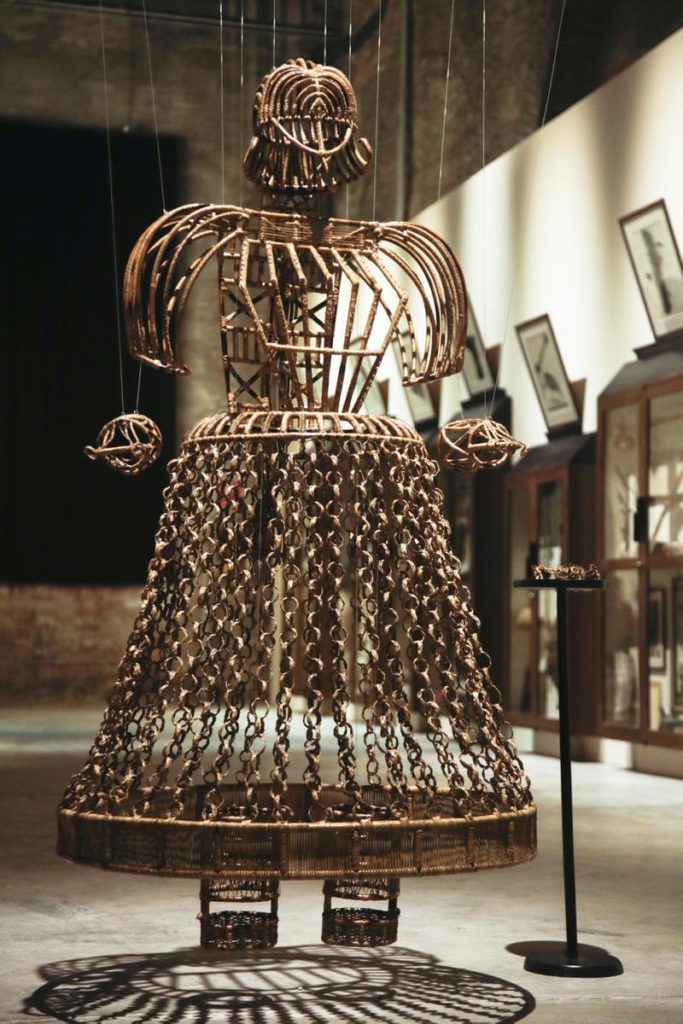
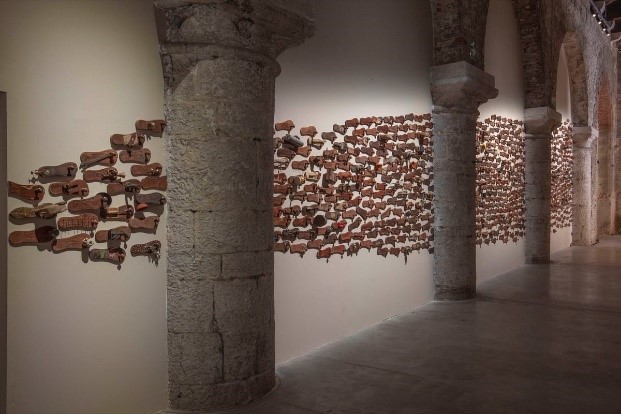
Returning after an eight year hiatus, India’s compelling group presentation addresses Gandhi’s legacy, beginning with Nandalal Bose’s posters for the 1938 Haripura Congress. In Broken Branches (2002), Atul Dodiya has recreated the old wooden cabinets found in the Gandhi museum in Porbandar, filling them with prosthetics, books, tools and weaving in personal items, while GR Iranna has covered one of the walls with hundreds of wooden padukas for his work Naavu (We Together) (2012), which refers to Gandhi’s choice of wood slippers—he rejected leather—and the power of collective marching. Jitish Kallat’s Covering Letter, projecting a plea for peace sent by Gandhi to Hitler on a curtain of descending mist through which audiences walk, simultaneously inhabiting and dissipating the text, is another key highlight. The pavilion theme marks the 150th anniversary of the birth of the Indian independence leader.
LITHUANIAN PAVILION
Sun & Sea (Marina): Rugilė Barzdž iukaitė, Vaiva Grainytė and Lina Lapelytė
Venue: Marina Militare, Calle de la Celestia, Castello
From 10am to 6pm every Saturday until the end of October, the Lithuanian pavilion is offering the spectacle of a beach of holidaymakers singing an “opera-performance” in a building that still belongs to the Arsenale’s military zone. The project is the work of theater director Rugilė Barzdžiukaitė, playwright Vaiva Grainytė, and composer Lina Lapelytė. It first debuted at Vilnius’s National Gallery of Arts in 2017 in Lithuanian and was adapted into English for the biennale, the pavilion is the 2019 recipient of the Golden Lion for Best National Participation.

Audience members become voyeurs, gazing down from balconies at the sandy stage set, where performers dressed in bathing suits and surrounded by seaside paraphernalia (lunch boxes, Sudoku, colouring books), casually sprawl on their towels and sun loungers. Their stream-of-consciousness libretto, alternating between solo songs and group choruses, is poetic, strange and often comic. But this microcosm of humanity comes with a barbed ecological message for the age of climate emergency.
PORTUGUESE PAVILLION
Leonor Antunes: a seam, a surface, a hinge or a knot
Venue: Palazzo Giustinian Lolin, San Marco, 2893

Leonor Antunes’ work in Palazzo Giustinian addresses the language and histories of Venetian Modernism. The artist begins with a black cork floor on the androne, the lowest level of the Grand Canal palazzo, dotted with brass squares. It is inspired by a Carlo Scarpa mosaic and lit by dramatically shaped lights designed by Egle Trinacanato, the first woman to graduate from Venice’s architecture school. Upstairs are partitions reaching up to the ceilings, echoing the rhythms of their wooden beams. Punctuating the space are tubular structures supporting tangled leather cords and woven screens and cooly minimal lights made in Murano glass. The evocation of history and sensitive response to the surrounding language of the palazzo and its furniture, makes for a poetic and evocative presentation of sculptures.
US PAVILION
Liberty/Libertà, Martin Puryear
Venue: Giardini

Martin Puryear’s pavilion entitled Liberty consists of eight sculptures that aim to present liberty as a universal, rather than an American, right. A significant work which presents a white column speared by a shackled iron stake is dedicated to Sally Hemings, Thomas Jefferson’s African-American slave and “concubine” who worked on his Virginia plantation. Other sculptures include a pair of wagons on a tilted plinth, evoking the precarious journeys of the American pioneers, as well as the present-day migrants maligned by the current US President.
FRENCH PAVILION
Deep See Blue Surrounding You: Laure Prouvost
Venue: Giardini

Visitors to Prouvost’s pavilion enter by the back door and are met with a rubble-filled basement, allegedly the start of the artists’ plans to dig a hole between the French and British pavilions. They then journey through a surreal sculptural seascape of marine creatures in Murano glass, cigarette butts and defunct mobile phones before plunging into darkness—the screening space is modelled on the belly of an octopus. The slipstream of watery images continues in the film as Prouvost’s characters make their way from the suburbs of Paris to Venice and the pavilion itself.
BRITISH PAVILION
Cathy Wilkes
Venue: Giardini

Cathy Wilkes’s sparse domestic installation of mannequins, lace scraps, diminutive vases of flowers, washing-up bowls and fragments of plastic limbs, is a meditation on austerity Britain, growing ever smaller in global significance. Tiny figures, with white discs for heads and distended grey bellies, reflect children of poverty and hunger. A mother of sorts is evoked in the stark white arms that rise out of a basin, as if petrified in the constant act of washing up, and in the headless figure in a green 30s dress that stands upon feet of clay. Wilkes presents a strong sense of dignity, restraint and coherence not to shock or amuse but inspire contemplation and reflection.
With ninety national pavilions, two group exhibitions in the Giardini and Arsenale respectively, and over twenty collateral exhibitions, there is an overwhelming amount of art to see at this year’s 58th edition of the Venice Biennale, running from May – November 2019. Below are The Fine Art Group’s highlights from one of the most influential art events of the year.

MAY YOU LIVE IN INTERESTING TIMES
EXHIBITION HIGHLIGHTS
The title curator Ralph Rugoff chose for his 2019 edition of the Venice Biennale is May You Live In Interesting Times. The phrase has a suggestive backstory: It is a fake Chinese proverb, first uttered by a British diplomat in the context of the rise of fascism in Europe. The exhibition is a response to the instabilities and challenges of the era, from the surge towards right-wing politics and climate change to artificial intelligence, fake news and surveillance.

The exhibition is entirely contemporary, with almost all works made since 2010, and nearly half the artists aged under 40. The comparatively reduced roster of 80 artists are exhibited simultaneously at the Arsenale as ‘Proposition A’ and the Giardini under ‘Proposition B’, which aims to spotlight a different side of each artist’s practice. Sometimes it offers a work that complements or completes a project in the other section, however on occasion it offers more of the same but in a new environment. Encouragingly for the first time half of the artists are women and all are alive.
Overall themes of the Biennale include American race relations, the looming dangers of climate change, human relations to technology and Artificial Intelligence. Highlights that cover these aspects include Cyprien Gaillard’s L’Ange du Foyer, a multicoloured hologram of the winged, clawed, fanged spirit in Max Ernst’s Fireside Angel, painted in fear of fascism in 1937, which darts and pounces about the Giardini’s shadowy, domed, mirrored central gallery.
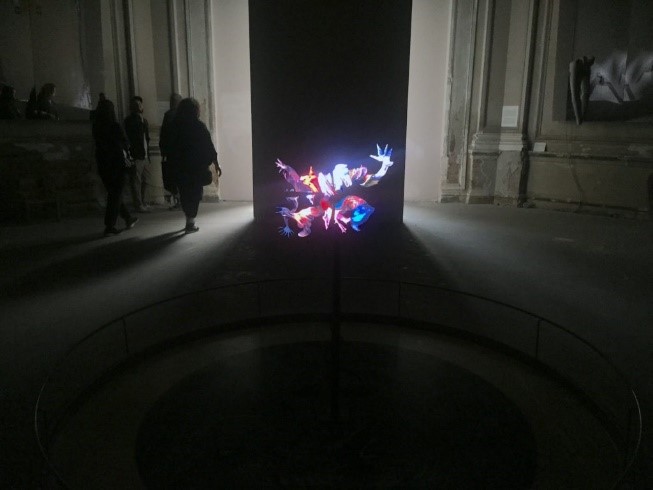
Christian Marclay’s impressive new 48 War Movies layers movies featuring conflicts from the American civil war to Iraq, on top of one other with just the outer edge of each visible, and all the soundtracks playing simultaneously, on shrieking infinite repeat, chaotic and endless, as war itself.
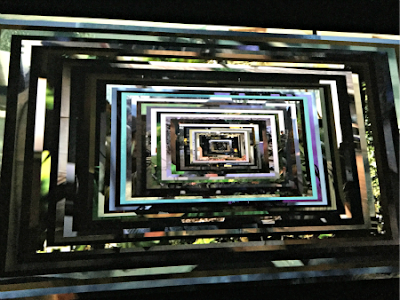
Michael Armitage’s most recent paintings, executed in the period leading up to Kenya’s 2017 elections, depict carnivalesque scenes in a cacophony of disrupted surfaces and tropical palettes that hover between vitality and threat. They re-appropriate western Modernism’s exotic tropes to express 21st-century black experience with emboldened success.
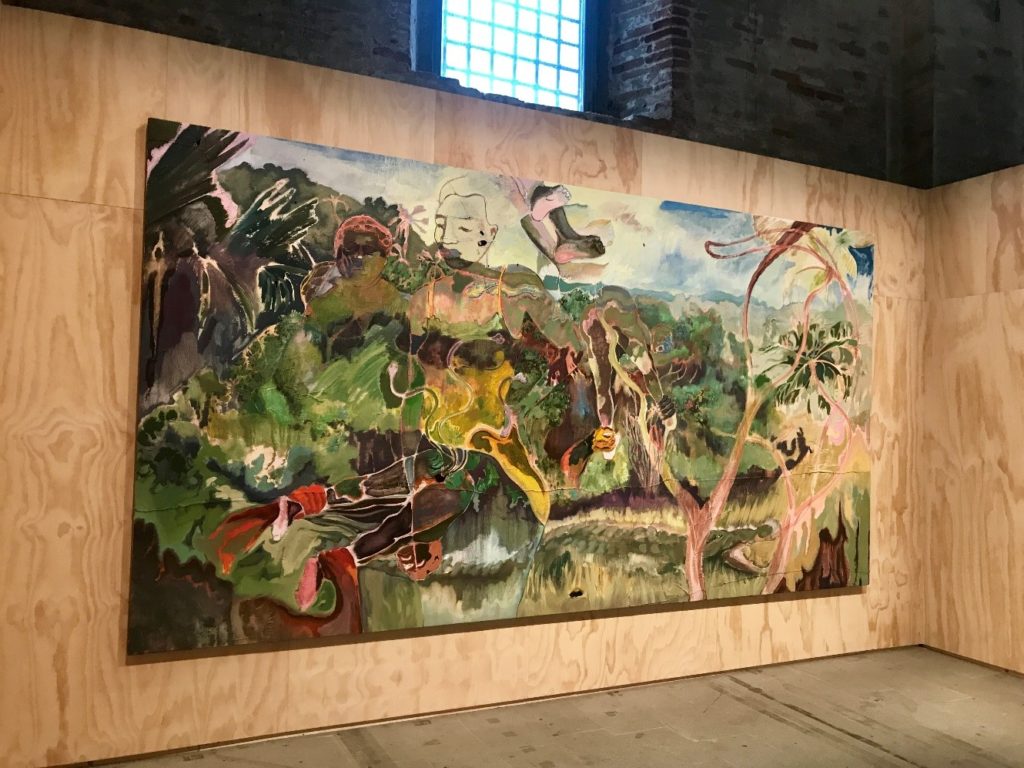
South African photographer Zanele Muholi’s self-portraits in various breath-taking costumes made by the artist, beautifully punctuate both the Arsenale and Giardini exhibitions.
Amongst the group of Njideka Akunyili Crosby works on show, the series of new portraits of herself and her family emerge as the most exceptional.
Henry Taylor’s submissions include scenes of life in modern America: a white business executive being hauled off in handcuffs, a group of black women watching the funeral of a victim of the bombing of the 16th Baptist Church in Birmingham, Alabama, in 1963.

Whilst the exhibition rightly gives overdue space to once side-lined kinds of identities within the Euro-American art industry; on the other hand, it is freighted with the market forces and trends that are propelling these artists forward. Other commercial inclusions such as Carol Bove’s striking abstract sculptures and George Condo’s largescale ‘psychological cubist’ paintings, currently staples at all international art fairs, prove that the Biennale is still very much in tangent with the art market. Despite this, the exhibition forcefully declares art’s engagement with present realities and its ability to push forward from traditional forms.
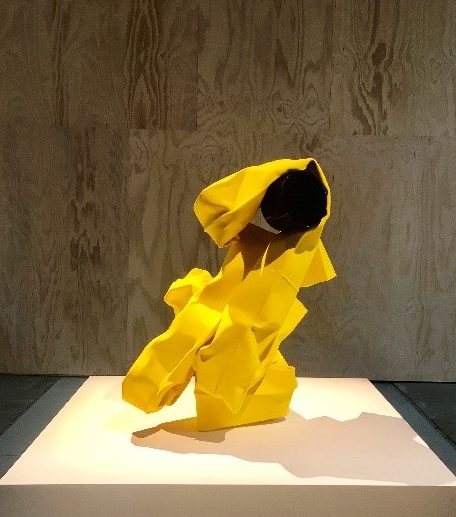
What ultimately emerges from Rugoff’s “interesting times” is a shipwreck of political and cultural stabilities – migrant tragedies, proliferation of repressive regimes, new inequalities- although the best share determined optimism and resistance. The most successful works express a sense of energy, the feeling that art in our globalised, digitally emancipated times has gained a momentum that will power it forward whatever the fates of individuals or nations.
$2 billion worth of art was sold during the New York May 2019 sales across 10 sales of Impressionist, Modern, and Contemporary art at Christie’s, Sotheby’s and Phillips, which is up $100 million from last year’s May 2018 sales totals, showing signs of a healthy and strong market.
IMPRESSIONIST & MODERN ART SALES
Both sales turned in “very solid results,” says Guy Jennings, an Impressionist and Modern specialist with The Fine Art Group…there’s “a lot of money chasing this kind of material,” Jennings says. “It’s a good market.”
CHRISTIE’S IMPRESSIONIST & MODERN ART EVENING SALE
Christie’s Impressionist & Modern Art Evening sale totalled $343.4m ($399m with premium) which sat comfortably within the presale estimate of $287.5m – $401.8m. Of the 63 lots offered, 54, or 86 percent, were sold.
The top lot of the sale was a still life by Cézanne, Bouilloire et fruits (1888–90) from the collection of Si Newhouse. Estimated in the region of $40m with feverish bidding, the work was eventually won by Rebecca Wei, president of Christie’s Asia, selling for $52m (hammer), having been purchased by the owner in 1999 for $29.4m.
Five blue-chip pieces from the Newhouse estate accounted for $100.1m, more than a quarter of the sale total. Another of the star lots from this selection included Van Gogh’s Arbres dans le jardin de l’asile, painted in Saint Rémy in 1889, which was estimated in the region of $25m. With at least five bidders on the work, it eventually sold for $33m (hammer). It was announced before the sale that both the Cézanne and the Van Gogh had new third-party guarantees in place.
New auction records were set for works by Balthus and Pierre Bonnard. The former selling for $19m (hammer) which more than doubled the previous record of $9.9m set at Christie’s New York in November 2015. Pierre Bonnard’s La Terrasse ou Une terrasse à Grasse (1912), from the Drue Heinz collection, solicited significant demand with bidding opening at $3.8m before hammering down at $16m. The previous auction record for a Bonnard was $11.6m at Christie’s London in February 2011.
SOTHEBY’S IMPRESSIONIST & MODERN ART EVENING SALE
Sotheby’s Impressionist & Modern Art Evening Sale totalled $301.6m ($349.9m with premium) against a pre-sale estimate of $252.6m – 353.2m. Fifty-one of the 56 works consigned to the sale found buyers, securing an impressive 91 percent sell-through rate. Despite some striking individual results nearly half the lots in the auction hammered beneath their low estimates highlighting some volatility in the Impressionist & Modern market.
Amongst the bought in lots was La Juenesse de Bacchus by French Academic painter William Bouguereau, an unusual inclusion in an Impressionist & Modern evening sale, and accordingly failed to find a buyer against its estimate of $25 – 35m.
The top lot of the evening, and the week, was Monet’s Meules (1890) selling for 44 times its 1986 price at $107.6m (hammer), the most expensive Impressionist work to ever sell at auction. Another key lot was Pablo Picasso’s 1962 canvas Femme au chien, offered by a Japanese collector and held for the last 29 years, the painting sold for $48m (hammer) against an estimate of $25 – 30m, with no guarantee.
Whilst Sotheby’s sale total was lower than Christie’s, the sale did outperform last year’s May sales total of $299.5m ($318m with premium). Significantly less lots were offered with guarantees indicating confidence in the market, however this shift attests to the varying prices with several lots selling beneath their low estimates.
POST-WAR & CONTEMPORARY ART SALES
CHRISTIE’S POST-WAR & CONTEMPORARY ART EVENING SALE
Christie’s Post-War & Contemporary Art Evening Sale totalled $468m ($538.9m with premium) against a presale estimate of $422.3 – 605.2m. Of the 56 total lots offered, 51 of them, or 91 percent, sold. The private collection of Robert and Beatrice Mayer achieved $157m, while works belonging to the late publishing magnate S.I. Newhouse accounted for $115m of the sale total, indicating the continued importance of estates in propelling strong sales totals.
The breakaway lot was Robert Rauschenberg‘s seminal silkscreen painting Buffalo II (1964), which after heated bidding sold to Sara Friedlander’s client for $78m hammer ($88.5m with premium) against an estimate of $50m, momentously surpassing the artist’s previous auction record of $18m. Other trophy lots included Jeff Koons’ stainless steel Rabbit (1986), estimated at $50-70m. Chased by 6 bidders, the work eventually sold to dealer Robert Mnuchin for $80m ($91m with premium) which exceeded the former Koons record of $58.4m and returned him to his post as the most expensive living artist, which he briefly lost to Hockney last year. Reportedly the end buyer was mega collector Steve Cohen.
“I think there was always going to be one which didn’t garner the same level of interest, and the Warhol just couldn’t hold up to the Rauschenberg and Koons,” Long says.
-Morgan Long, Senior Director: Barron’s Newspaper
The Warhol market proved soft with Double Elvis, whose $48m hammer price was below the estimate of $50 – 70m, with scant bidding, likely selling to the guarantor. Similarly, Early Colored Liz (1962) sold to Gagosian for $16.8m hammer against an estimate of $20 – 30m, demonstrating lack of demand at the top end of the market. Meanwhile Louise Bourgeois‘s Spider (conceived in 1996, cast in 1997), estimated at $25 – 35m, sold to Xin Li for an auction record price of $28m ($32m with premium). Other records included Larry Rivers ($1.2m), Frank Stella ($28m), Daniel Buren ($2.1m), and Jonas Wood ($4.9m).
PHILLIPS 20TH CENTURY & CONTEMPORARY ART EVENING SALE
Phillips 20th Century & Contemporary Art Evening Sale totalled $85.3m ($99.9m with premium) against a presale estimate of $75.9 – 107.8m, with only one of the 43 lots failing to sell.
The top lot of the evening was Willem de Kooning’s, Untitled XVI (1976), which hammered at $8.8m ($10.3m with premium), towards the low end of the estimate. However, it was the younger contemporary artists whose work really soared throughout the evening. Examples include Dana Schutz’s painting Signing which sold for nearly quadruple its low estimate at $980,000. Swiss artist Nicolas Party’s landscape sold for $608,000 against an estimate of $100,000 – $150,000 and Jordan Casteel’s Self Portrait sold for $237,500 from an estimate of just $60,000 – 80,000.
From the 15 works offered from the Fiterman collection, one of the most valuable consignments Phillips has secured in its history, three sold above estimate but overall the group performed solidly within expectations. The collection’s top lot was Horse and Rider (1976) by Roy Lichtenstein, selling for just below the $6m low estimate with fees.
Over half the works in the sale were guaranteed, including Helter Skelter II (2007) by Mark Bradford which sold to the guarantor for $7.7m (hammer). The abstract collage is the companion piece to Helter Skelter I, which John McEnroe sold at Phillips last year for $12m, bought by The Broad collection it currently stands as the record for the artist.
SOTHEBY’S POST-WAR & CONTEMPORARY ART EVENING SALE
Sotheby’s Post-War & Contemporary Art Evening Sale totalled $291.6m ($342m with premium) against a presale estimate of $244.6 – 351.4m. 56 of the 63 lots sold, with an 89 percent sell through rate.
With 79 percent of lots selling for above or within their estimates, the auction included records for seven artists, ranging from established artists Carl Andre, Lee Krasner, and Kenneth Noland to contemporary figures including Charles Gaines, Barkley L. Hendricks, Rashid Johnson, and Dana Schutz. The Schutz notably soared through its estimate of $300,000 – 400,000 hammering at $2m ($2.4m with premium). This record was swiftly increased from $980,000 when Phillips sold her Signing (2009) just 90 minutes earlier.
Francis Bacon’s Study for a Head (1952) was the sale’s top lot. From the collection of Richard E. Lang and Jane Lang Davis, the work sold for well above its $30m high estimate to make $44m ($50.4m with premium) to dealer Chris Ekyn who was bidding from the floor. Less dramatic was the sale of SFMOMA’s Rothko which sold neatly within its estimate for $43.8m ($50.1m with premium) to a client of Amy Cappellazzo.
SUMMARY
The highest price paid for a single artwork across all collecting categories in New York this sales cycle, was the $110.7m (incl. premium) Monet Meules painting sold by Sotheby’s, however overall Christie’s sales totals trumped Sotheby’s & Phillips across both categories.
The Impressionist & Modern Sales were down from the May 2018 sales however this was due to the Rockefeller single owner sale. Compared to November 2018 totals were up 24.3% with strong demand for top lots with estimates over $10m. Sales values in the Post-War & Contemporary category were up 7.6% from May 2018 sales.
Despite multi-million dollar records being set at the top end for Jeff Koons and Robert Rauschenberg, younger generation artists saw the most significant price jumps. Amongst the lots that received the most competitive bidding were works by Dana Schutz, KAWS, Nicholas Party, Jonas Wood, Rashid Johnson, Lynette Yiadom-Boakye and Jordan Casteel. In total these artists raised $22.9 million against a pre-sale mid-estimate of $11.6 million (based on 14 lots). The next several sale cycles will attest to the sustainability of this market attention and speculation and these artists will be closely watched.
PRESALE ESTIMATES & SALES RESULTS
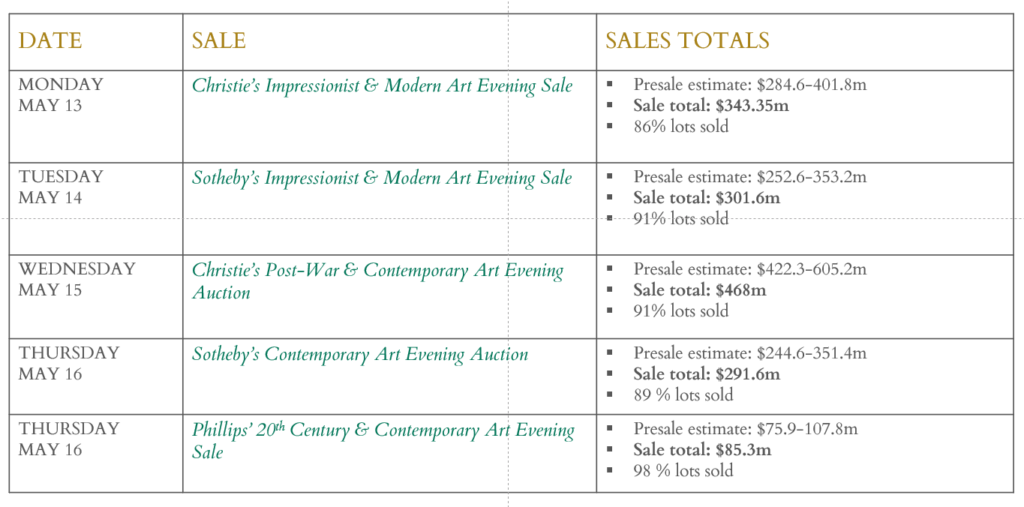
HOW PHILIP HOFFMAN BEGAN ART COLLECTING
In my early twenties my brother and I were captivated by the illustrator and satirist, William Heath Robinson. It was one of these absurd and charming drawings of an ad hoc contraption that became the first work I ever purchased. I think it was Robinson’s imagination that had me so intrigued. Today, the walls of my study are covered floor to ceiling with the original cartoons from the early 1900s.
A little later I began to collect antiquarian books. The obsession started when I was studying at York University; I used my student loan to buy an 18th century rare book on wine for £100 – thus complimenting my then and continuing interest in wine! A few years ago, when we renovated our home in London, I had a library specifically built to house my ever increasing antique and rare books collection. However, I will always value my first, and it has stood proudly in my library for over 40 years.
Since I started working in the art world, at least 30 years ago, my taste has slowly developed and changed and I’ve been heavily influenced by my wife, Nicky. It was Nicky who encouraged me to buy my first ‘real’ picture, a Bridget Riley at FIAC in Paris. I have always been interested in Modern British art, and I think Riley is one of the most revolutionary British painters of them all and I am looking forward to her upcoming retrospective this year.

ART AS COLLATERAL: SHIPPING & HANDLING
A young entrepreneurial collector working with The Fine Art Group’s advisory team to develop his contemporary art collection, was seeking a 2-year loan of $4 million against his collection. His long-term ambition is to found a private museum and display his collection to the public. However, with much of his capital invested in his expanding tech business, he was seeking to lever the capital reserved for his art acquisitions.
The Fine Art Group identified six contemporary artworks that were suitable collateral. Not only was the collateral spread across the collector’s international residences but it also included a delicate work on paper and a monumental sculpture. The Fine Art Group utilised the services of fine art shipper Gander & White to undertake collection, transport and storage of all artworks needed as collateral for funding of loan monies. Gander & White has a worldwide presence, with facilities in the UK, France and USA which enabled swift collection of collateral from the individual’s global residences. These works were packed and transported in bespoke crates crafted by Gander & White.
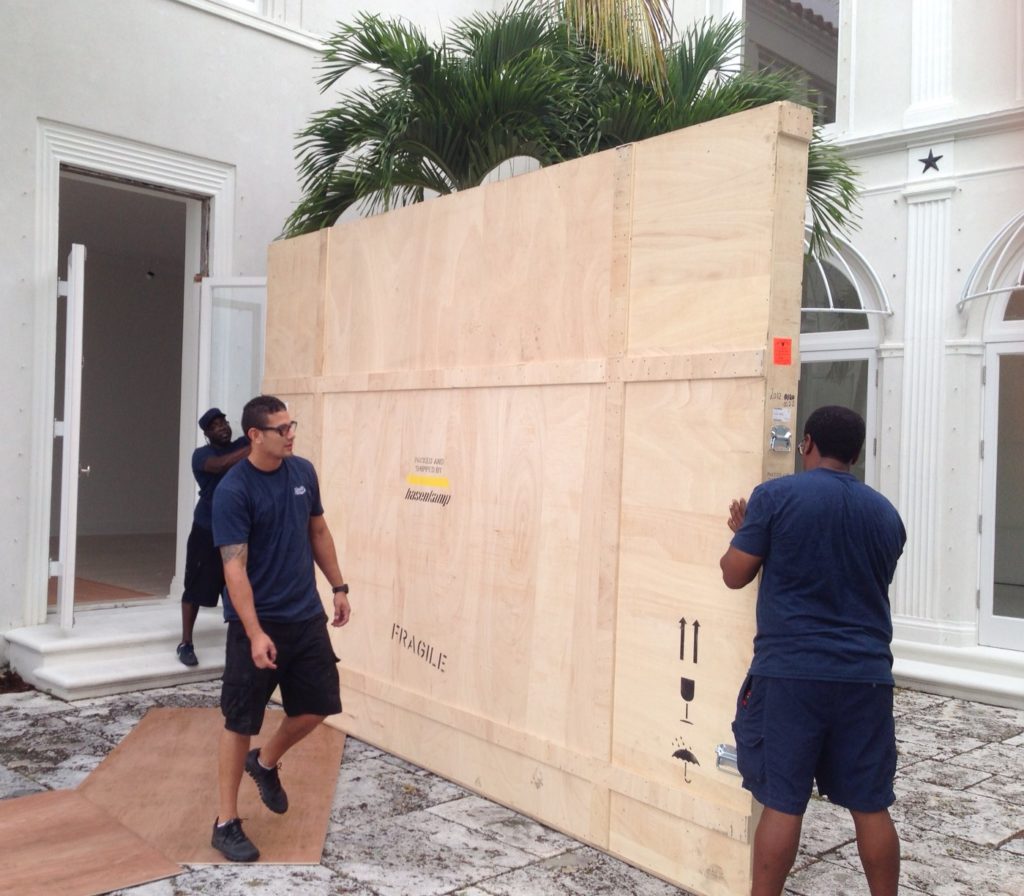
The pieces chosen as collateral varied in size, media, and complexity to transport. The large sculptural piece required a gantry to move. This work was successfully deinstalled by Gander & White and ultimately stored in one of the company’s state-of-the-art fine art facilities. These facilities contain environmentally-controlled private rooms ideal for storing such high-value works. The collateral also included a group of works on paper that required delicate and precise handling from beginning to end. These were transported to storage using a climate-controlled vehicle, where they were then placed in a secure and controlled environment. Both the collector and The Fine Art Group were confident that the artworks were in safe hands.
Oliver Howell, European Managing Director at Gander & White, said of this project: “We were pleased to support The Fine Art Group in this international operation. The Fine Art Group offers an important service to art collectors and investors alike and it was a pleasure to once again work with a company who share our commitment to offering the best service to our respective clients”.

The collector also wished to show his works in multiple international museums and The Fine Art Group was pleased to facilitate this request, with the support of Gander & White, who work extensively with institutions. The Fine Art Group’s in-house legal team put in place all the necessary legal framework with the museums and the collectors, including establishing complex security structures, negotiating loan documentation, liaising with the museums, and organising insurance and logistics on the collector’s behalf. Gander & White worked with other agents belonging to the international fine art shipping network ICEFAT to carry out the shipping and installation of works in museums in Australia, Singapore and the UK.
This enabled the collector to realise his personal ambition of having his works exhibited for the public in major retrospective exhibitions globally. He continues to build his collection with the Fine Art Group’s advisory team purchasing emerging artists on the primary market, as well as some established blue-chip artists.
“It is important to me that our partnered service providers uphold the high-quality client service that we offer our clients. Gander & White enabled The Fine Art Group to facilitate every one of our clients’ needs as efficiently and professionally as possible.” – Freya Stewart
To learn more about Gander and White/The Fine Art Group you can subscribe to their newsletter here.
THE FINE ART GROUP: LEADING ART FINANCE PROVIDER
With the acquisition of Falcon Fine Art’s art-secured loan book, The Fine Art Group further cements its position as a leading art finance provider. It marks the first significant consolidation of specialist art lenders in a maturing and growing art financing market.
“We are delighted with the acquisition of Falcon Fine Art. This inaugural art-financing business consolidation strengthens our long-term commitment to being the leading art finance provider to collectors and owners of high value art globally. This is an exciting time for our business as demand for our art financing product increases – we look forward to continuing to deliver the best art lending service to our clients.”
– Freya Stewart, CEO of The Fine Art Group’s Art Lending business
The Fine Art Group founded its art-secured lending practice three years ago to provide specialist art-secured financing to collectors and owners of high-quality art and jewelry, under the leadership of Freya Stewart. Having established a strong track record in the art lending space, with a commitment to provide financial solutions for a growing global client base, The Fine Art Group was the natural buyer for Falcon Fine Art.
Kamel Alzarka, the Chairman of Falcon Group, said: “This sale makes perfect sense, as we continue to focus on the growth and expansion of our core business, providing solutions for our large corporate clients.”
ART COLLECTED WITH PASSION
The late Walid Juffali collected art with passion. As his daughter Dina emphasises, “He bought with his heart, always collecting things that he loved, things that he was attracted to… the value of art is how it feels. It’s so personal – that’s what makes it interesting, it’s very emotional.”
The upcoming sale of Walid Juffali’s collection on 26th March through Bonhams at Bishopsgate House shows the magnitude of the collector’s passion for art. The collection spans centuries counting a vast Chihuly chandelier, and works by masters such as Andy Warhol, Picasso, Joan Miro, Marc Chagall, Henri Lebasque and Leonard Foujita. There are also collections of porcelain, silver, English and French furniture, books, fine wines and objets d’art.
WALID’S LIFE OF SERVICE
Philanthropy played an important role in Walid’s life. His mother Suad al-Husseini is a renowned philanthropist in the Middle East, and his family have decided to donate a proportion of the sale proceeds to Macmillan Cancer Support and Cancer Research in his memory.
“The Fine Art Group is delighted to be working with the Juffali family on the sale of this unique and incredibly personal collection. The many works available in the sale illustrate a true richness of taste, from the refined period furniture to the daring glass works of Dale Chihuly. From the monumental sculptures of Fernando Botero to the intricate antique clocks and silverware, the collection demonstrates the interests of a person with deep aesthetic sensibilities. It is rare that such a special and diverse collection comes to sale and it has been an honour to be so deeply involved in the proceedings.”
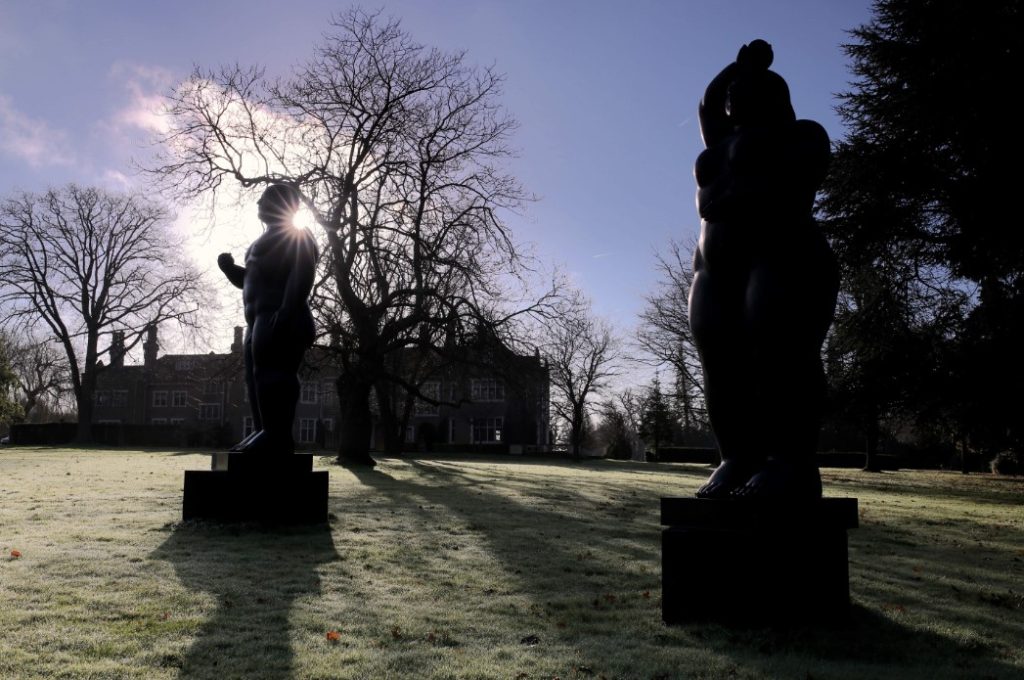
Throughout Bishopsgate house, works by Warhol and Picasso, Miró and Chagall indicate Walid’s passion for modern art. “The contemporary movement wasn’t so much what was valued by Middle Eastern society at the time,” Dina explains. “You had your Picassos, to them that was Contemporary. But life is a treasure hunt – you have to go out and find what you’re meant to have, and Miró spoke to my father on a very bold level – they’re quite abstract but it gives you a lot of emotion, it has something to it. It’s not like a Calder, which is very bold and straightforward; Miro has layers and nuance.”
SCULPTURES
One of the most striking lots is Fernando Botero’s Adam and Eve two monumental bronze statues on the huge stretch of lawn overlooking Windsor Great Park. “My father first saw Botero’s work in Monaco,” says Dina, “and he always felt it should be seen out of doors. I mean, everyone loves Botero… and he just thought, that’s a piece and a half!”
The sale will include two sculptures by Dale Chihuly commissioned by Walid for Bishopsgate House; a magnificent chandelier placed above the blue-tiled pool and Float Boat, a sailing fantasia rendered in glass on the grounds. “My father met Chihuly before he was a big name. I remember Dale coming over to have a look at the space – I’ll never forget his paint-splattered boots – and he thought ‘Why not, let’s do it’. This was before the V&A got its installation.” Dina explains how her father bonded with Chihuly, “They were both quite creative characters, so they meshed really well – and it became effortless for Dale to create the most perfect, organic pieces.”
The Chihuly sculptures are a great example of how personal Walid’s collecting process was, and how much he was led by his heart.
26 March 2018
Bishopsgate House, Englefield Green, Egham TW20 0XT
Previews at Bishopsgate House Friday 23 – Sunday 25 March
View the online catalogue here.
OUR SERVICES
Offering expert Advisory across sectors, our dedicated Advisory and Sales Agency teams combine strategic insight with transparent advice to guide our clients seamlessly through the market. We always welcome the opportunity to discuss our strategies and services in depth.